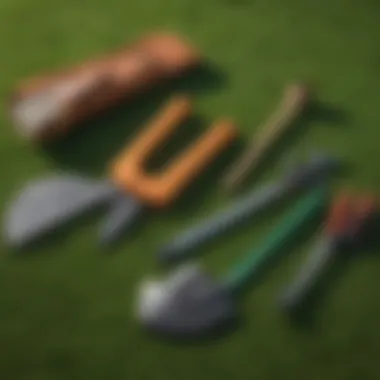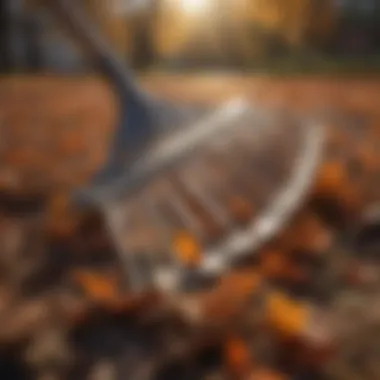Effective Strategies for Leaf Removal in Your Yard


Intro
Removing leaves from your yard can seem like a simple task, but there are nuances that many may overlook. Leaves can vary in type, size, and fall patterns, affecting how you approach removal. Understanding effective strategies is vital for both the aesthetic and health of your yard. Different tools and techniques exist to help manage leaf litter without harming the environment. In this article, we will discuss various methods and considerations for effectively removing leaves while respecting the surrounding ecosystem.
Key Concepts and Terminology
Basic Definitions
To understand leaf removal techniques, it is important to consider some basic terms:
- Deciduous Trees: Trees that shed leaves annually. They contribute large volumes of foliage in specific seasons.
- Mulching: A method of processing leaves into smaller pieces for use as ground cover or compost.
- Raking: The traditional method of gathering leaves, either by hand or using tools.
Historical Context
Historically, leaf removal was purely manual. Homeowners utilized rakes and hand tools for maintenance. As urban areas expanded, public spaces began to implement collection services. This marked a shift in approach, integrating efficiency and labor-saving technologies into leaf management. Today, both traditional and modern methods coexist, providing options for various preferences and needs.
Recent Innovations and Trends
Technological Advancements
Recent advancements in leaf removal tools have revolutionized the way we manage leaves:
- Leaf Blowers: Devices that allow faster collection of leaves by blowing them into piles for easy gathering.
- Robotic Lawn Mowers: Some models now include features for leaf collection, reducing manual labor.
- Electric Mulchers: These machines quickly convert leaves into mulch, making the material useful for gardens.
Sustainable Practices
As awareness of ecological impacts increases, sustainable leaf removal practices have gained popularity:
- Composting: Turning leaves into compost not only reduces waste but also enhances soil health.
- Using Leaves as Mulch: This method prevents soil erosion and retains moisture.
- Natural Bug Repellent: Some leaves, when left in the garden, provide habitats for beneficial insects.
Practical Applications and Techniques
Step-by-step Guides
When tackling leaf removal, consider employing these methods:
- Preparation: Start by assessing the yard. Identify areas with heavy leaf coverage.
- Choose Your Tools: Depending on the volume of leaves, select from rakes, blowers, or mulchers.
- Gathering Leaves: Utilize the chosen tool to collect leaves into manageable piles.
- Disposal: Decide if you want to mulch, compost, or send leaves to a municipal collection service.
Case Studies
Many homeowners have successfully implemented various leaf removal strategies:
- A suburban family transitioned from traditional raking to electric mulching. This reduced their physical strain and enhanced their garden's health.
- A community focused on sustainable practices initiated a program to encourage composting of yard waste, realizing a significant decrease in landfill contributions.
Implementing an efficient leaf removal strategy not only beautifies your yard but also supports the ecosystem.
Understanding the Challenge of Leaf Accumulation
Leaf accumulation is a common challenge for many homeowners. The importance of understanding this issue lies not only in maintaining an aesthetically pleasing yard but also in preserving the health of the lawn and soil. Leaves may appear harmless, but their presence can lead to several underlying problems if not managed correctly.
Why Leaves Fall
Leaves fall primarily as a response to changing seasons. In autumn, many trees shed their leaves to conserve water and energy during colder months. This natural process also allows trees to go dormant, which is crucial for their survival in harsh winter conditions. However, the aftermath of this cycle becomes relevant for homeowners. The sheer volume of leaves can cover lawns and garden beds, potentially smothering the grass beneath. Thus, an understanding of this seasonal change can aid in more effective yard management.
Impact of Leaf Accumulation on Yards
Accumulation affects yards in various ways, especially impacting health and the quality of the soil.
Effects on Lawn Health


Leaves can significantly affect lawn health. As they pile up, they block sunlight from reaching grass blades. This deprives grass of the necessary photosynthesis process. The result can be yellowing patches, bare spots, or even dead grass areas. Besides aesthetic concerns, unhealthy lawns might require more water and nutrients. This process creates a cycle where poor lawn health leads to increased resource use. Hence, understanding the effects of leaves gives homeowners insight into better acting before lawn damage occurs.
Implications for Soil Quality
Soil quality is another factor affected by leaf accumulation. While some leaves can contribute nutrients to soil when decomposed, in high quantities, they can lead to compaction. Over time, this compaction adversely affects soil aeration and drainage. Poor soil conditions can hinder root growth, making plants less resilient to stresses such as drought or disease. Therefore, recognizing the implications of leaf accumulation help homeowners maintain healthy soil life.
Effective leaf management is crucial for both lawn and soil integrity. Neglecting to address leaf buildup could lead to complicated agricultural challenges.
Tools for Leaf Removal
The process of removing leaves from your yard is greatly influenced by the tools you choose to employ. Each tool has its own strengths and weaknesses, and understanding these can make a significant difference in your leaf management strategy. Proper tools can enhance efficiency, reduce physical strain, and improve the overall outcome. When considering your leaf-removal needs, it’s crucial to explore both manual and mechanical options. Each category of tool can serve different purposes based on the scale of leaf accumulation and the specific conditions of your yard.
Manual Tools
Rakes
Rakes are one of the most traditional tools for leaf removal. Their simplicity and effectiveness are key traits that contribute to their popularity. A rake’s broad and flat head allows for large swaths of leaves to be gathered quickly. The lightweight construction means less fatigue during extended use, making them suitable for both small and large yards.
One notable advantage of rakes is their minimal environmental impact, as they do not consume any power. However, they do require physical effort, especially if there’s a significant amount of leaves. Using a rake does demand proper technique to maximize efficiency, such as raking in straight lines and keeping the head just above the ground to collect leaves effectively.
Handheld Leaf Collectors
Handheld leaf collectors serve as an efficient addition to the arsenal of manual tools. This tool is particularly effective for smaller areas and garden beds where precision matters. The design typically includes a broad mouth that can scoop up piles of leaves with ease.
The user-friendly nature of handheld leaf collectors allows for quick gathering without the need to bend over too much. Their portability and ease of use make them a popular option for quick cleanup tasks. However, they may not be ideal for large areas since they tend to require multiple passes to gather leaves completely, potentially leading to more time spent on a larger task.
Mechanical Tools
Leaf Blowers
Leaf blowers represent a substantial advancement in leaf removal technology. These devices take advantage of airflow to move leaves with ease, making them an effective choice for larger yards where traditional methods may be too labor-intensive. Leaf blowers are praised for their speed and efficiency, allowing users to clear a significant area in a short amount of time.
However, one should consider the noise associated with leaf blowers. Many are powered by gasoline, which can increase overall noise levels. There are electric models available as well, which tend to be quieter but may lack the power of their gas counterparts. Users should weigh the benefits of time savings against the potential disturbance to themselves and neighbors.
Vacuum Systems
Vacuum systems are another mechanical tool that offers a different approach to leaf management. These systems not only blow leaves but also vacuum them up, collecting debris directly into a bag or container. This dual function simplifies the process, especially for those who desire a tidy yard appearance.
The major benefit of vacuum systems is their ability to remove leaves without the need for subsequent cleanup. You can eliminate leaves and other debris in one go. However, their effectiveness can be limited by debris size; larger twigs or branches may cause blockages. Additionally, these systems can vary in power and may require regular maintenance to ensure operation.
Innovative Technologies
Robotic Leaf Removers
Robotic leaf removers are emerging technologies aimed at simplifying yard maintenance. These devices often operate autonomously, navigating through your yard to gather leaves without direct human intervention. Their efficiency and convenience are significant draws, especially for those who value automation and wish to minimize labor.
One key characteristic of robotic leaf removers is their ability to cover large areas over time. They typically utilize sensors to avoid obstacles and can be programmed for regular operation. However, they are a more significant financial investment compared to traditional tools. Additionally, they may not be as effective in heavy leaf fall conditions, where the sheer volume of leaves might overwhelm their collection capacity.
"Selecting the right tools for leaf removal is crucial for a successful yard maintenance strategy. Each tool has its distinct role that can cater to different yard sizes and debris conditions."
Understanding the pros and cons of each type of tool allows homeowners and gardening enthusiasts to make informed decisions regarding their leaf management approach. This informed selection of tools ultimately leads to more effective yard care.
Methods of Leaf Removal
Effectively removing leaves from your yard is not just a matter of aesthetics; it plays a crucial role in maintaining the health of your lawn and garden. Different removal methods cater to various yard conditions and leaf types. Understanding these methods allows homeowners to choose the best practices that align with their needs while considering labor and environmental impact.
Raking Techniques
Best Practices for Efficiency


Efficiency in raking is vital for minimizing physical effort and time spent on leaf removal. One important aspect is to rake in a systematic manner, working from the periphery of the yard towards the center. This technique not only gathers leaves effectively but also prevents scattering. A key characteristic of efficient raking is the proper angle of the rake, which can significantly impact the amount of leaves gathered with each stroke.
Additionally, using the right type of rake, such as a lightweight plastic rake, can reduce strain and improve efficiency. This method is a popular choice because it requires no fuel or electrical power, making it eco-friendly. It also allows for precise control in gardens or areas with delicate plants which might be disturbed by mechanical methods.
Using Leaf Blowers
Operational Guidelines
When utilizing leaf blowers, adhering to operational guidelines is essential for effectiveness and safety. First, it is important to familiarize yourself with your specific leaf blower model, determining its power settings and operational capabilities. The ideal approach involves starting at one end of the yard and directing the leaves toward a designated collection point. This systematic method facilitates a thorough clearing of debris.
One key characteristic of leaf blowers is their ability to cover large areas rapidly. This efficiency contributes to their popularity among homeowners with extensive lawns. Nonetheless, it's worth noting that leaf blowers can be more challenging to control in tight spaces. Also, users must be mindful of wind conditions to avoid blowing leaves back into cleared areas.
Noise Considerations
Noise is a significant factor when using leaf blowers. Many models produce sound levels that can exceed findings typical measures of noise impact in residential areas. Thus, considering when and where to operate your leaf blower is crucial to maintain good relations with neighbors. A key characteristic of noise considerations is the potential disturbance it causes, especially during early mornings or late evenings.
Choosing a quieter model or using the blower during acceptable hours can alleviate many concerns regarding noise. Moreover, electric or battery-operated models generally produce less noise than gas-powered ones, making them a more neighbor-friendly choice.
Vacuuming Leaves
Advantages and Disadvantages
Vacuuming leaves presents a unique method that combines effectiveness with ease of use. A distinctive feature of this approach is that it often mulches leaves as they are vacuumed, providing a ready source of organic material for composting. This functionality can result in less waste while enriching the soil.
However, while vacuuming can be highly efficient on paved areas, it may struggle on uneven surfaces or in deeper leaf piles. The need for electrical power or gas also makes this method less convenient for some users. Therefore, balancing these advantages and disadvantages helps in making informed decisions on cleaning your yard.
Composting Leaves
Benefits for Soil Health
Composting leaves provides a sustainable method of dealing with yard waste while benefiting garden soil. This practice adds essential organic matter back into the ground, improving soil structure, moisture retention, and nutrient supply. A key aspect of composting leaves is the enhancement of soil health, as decomposed leaves introduce valuable microbes and improve overall biodiversity.
This method is popular not only for its environmental advantages but also for its cost-effectiveness; it allows homeowners to reduce waste disposal fees and create their own fertilizer. Composting is also time-consuming, requiring management of the compost pile to ensure an active decomposition process.
Steps to Follow
Composting leaves involves a series of steps that ensure effective breakdown and nutrient release. Begin by shredding the leaves, which accelerates decomposition. Next, create layers in your compost bin by alternating green materials, such as grass clippings, with brown materials, like the shredded leaves. Maintain moisture levels for optimal decomposition and turn the pile regularly for aeration. Following these steps allows for a successful composting experience that enriches your yard.
"Composting not only helps manage yard waste, but also plays a critical role in improving soil health and stability."
Seasonal Considerations
Managing leaves effectively involves understanding seasonal variations. Each season presents unique challenges and opportunities related to leaf accumulation and removal. By recognizing these factors, homeowners and gardening enthusiasts can implement targeted strategies that align with the natural cycles of their environment. This enhances not only the appearance of their yards but also promotes overall ecological health.
Fall Leaf Management
In fall, the primary challenge is the sheer volume of leaves that descend from trees as they prepare for winter. Trees shed their leaves to conserve water and energy, leading to a vibrant, but often overwhelming, carpet of foliage on the ground. It is vital to address this seasonal debris promptly. Failure to do so can result in smothered grass and increased pest habitats, while also harming soil health.
Effective fall leaf management involves:
- Regular Raking: This involves clearing leaves before they pile up, preventing matting and decomposition. It can be helpful to rake on a dry day to make the task easier.
- Using Leaf Blowers: High-powered leaf blowers can accelerate the cleanup, especially in larger yards or areas with many trees. However, users must consider the noise and potential neighborhood disturbances associated with these machines.
- Mulching: If leaves are shredded, they can become mulch. This technique retains moisture and enriches the soil, giving the yard a beneficial boost for the coming seasons.
Winter Preparation
As winter approaches, leaf management shifts to preparing the yard for the colder months. It is important to ensure that the lawn is free from accumulated leaves before snow covers it. Unattended leaves may lead to mold and disease when trapped under snow.
Key actions during the winter preparation include:
- Final Cleanup: Conducting a thorough raking of remaining leaves is essential in late fall. Clearing leaves protects the grass and prevents fungal issues.
- Assessing Soil Health: Post-cleanup is also an excellent time to evaluate soil health and apply organic matter like compost. This activity prepares the soil for spring plant growth.
- Protecting Landscape Features: Ensure that garden beds and other landscaping elements are clear of debris to withstand snow loads. This can help maintain the structural integrity of installed features over the winter months.


Spring Cleanup
Spring brings renewal, but it also signifies the need for a comprehensive cleanup following winter dormancy. After thaw, yards often present remnants of leaves, sticks, and other natural debris. This is crucial for starting the growing season effectively.
Practices in spring cleanup include:
- Thorough Raking: Removing any leftover leaves and debris is necessary to allow sunlight and air to reach the grass. It prevents shaded areas that can lead to poor growth conditions.
- Aeration: Following leaf removal, aerating the lawn helps improve soil compaction. This enables new growth and ensures nutrient absorption.
- Mulching and Composting: Any leaves collected can be processed into mulch or compost, returning valuable nutrients to the soil and enhancing garden health.
Remember, effective seasonal management of leaf removal not only benefits your yard but also supports the local ecosystem.
Environmental Considerations in Leaf Removal
The process of leaf removal should be viewed through the lens of environmental sustainability. Decision-making in how to manage leaf litter not only affects the immediate aesthetics of your yard, but also plays a crucial role in local ecosystems. Ensuring that leaf removal strategies align with ecological well-being can have long-term advantages not only for your yard but also for the broader environment.
Biodiversity Impact
When leaves accumulate in yards, they provide shelter and habitat for various organisms, including insects and small mammals. Removing all fallen leaves can disrupt these habitats, reducing local biodiversity. It is important to recognize that some leaves can be left in place or managed in a way that preserves wildlife. Here are several considerations:
- Habitat for Organisms: Leaves serve as a crucial habitat for overwintering insects and microorganisms. Leaving some areas untouched allows these species to thrive.
- Natural Nutrient Cycle: Decomposing leaves contribute organic matter to the soil, enhancing its health. This process helps in supporting plants and promoting a diverse range of species.
- Recreational Spaces: Unmanaged leaf spaces can offer a natural aesthetic. They can be areas for exploration and learning about biodiversity for children and adults.
By making thoughtful choices regarding leaf management, you can help maintain and even enhance biodiversity in your yard.
Pesticide Use and Alternatives
Pesticide application can often seem like a quick solution to manage pests that thrive in leaf litter, but this approach comes with significant risks. Pesticides may harm beneficial organisms and can contaminate soil and water. Therefore, it is essential to explore alternative methods:
- Manual Removal: Using rakes or leaf blowers allows the removal of leaves without chemicals, preserving the natural dynamics of your garden.
- Natural Predators: Encouraging birds and natural predators in your yard can help control pest populations without the need for pesticides.
- Organic Products: If necessary, consider using organic pest control solutions that are less harmful to the environment compared to conventional pesticides.
Using pesticides can resolve an immediate issue but may create long-term problems for the ecosystem. Seek to minimize reliance on chemical solutions by considering integrated pest management strategies.
Understanding the environmental implications of your leaf removal strategies is crucial. By promoting biodiversity and minimizing pesticide use, you contribute positively to the health of your yard and the larger environment.
Community Approaches to Leaf Management
Community approaches to leaf management are critical for maintaining a clean and healthy environment. They highlight collective action, where neighbors work together to tackle leaf accumulation. This method not only reduces the burden on individual households but also fosters a sense of community. By relying on shared resources, communities can combat leaf litter more efficiently, leverage manpower effectively, and minimize costs associated with leaf disposal. Collaboration can lead to better outcomes by combining different skills and tools available within the neighborhood.
Neighborhood Clean-Up Initiatives
Neighborhood clean-up initiatives offer a structured way for residents to address leaf management collectively. Organizing local events can motivate community members to participate actively. These events can range from casual weekend clean-ups to more structured seasonal drives. Coordinating these gatherings enables residents to share tools and equipment, which reduces individual costs.
Such initiatives also promote community bonding. People work alongside neighbors, building camaraderie as they tackle the shared issue of fallen leaves. Furthermore, organizing these clean-ups instills a sense of responsibility toward maintaining the community's aesthetic and ecological health.
In addition, neighborhood clean-ups can be publicized through local social media platforms like Facebook or community bulletin boards. Public engagement raises awareness about the importance of leaf management while encouraging even those who may not participate to consider the environmental implications of leaf litter.
Public Services for Leaf Disposal
Public services for leaf disposal are essential support systems that complement community efforts. Many municipalities offer collection services specifically for organic yard waste, including leaves. Participating in these programs offers residents a practical solution to dispose of leaves sustainably, reducing their environmental footpront.
These services typically operate on a scheduled basis, allowing homeowners to plan their yard maintenance accordingly. Clear guidelines on how leaves should be prepared for pickup—like bundling or placing them in designated bins—are often provided. This standardization makes the disposal process more efficient.
Public services also help alleviate potential health hazards. Accumulated leaves can lead to pest infestations and become breeding grounds for mold. By ensuring timely collection and disposal, local governments significantly mitigate such risks.
Moreover, municipalities might offer educational resources about best practices in leaf management, fostering a more informed community. As a result, the collaboration between residents and public services optimizes leaf management strategies, promoting environmental stewardship.
Finale
In this article, the conclusion serves as a critical reflection on the various effective strategies for leaf removal from your yard. Understanding these practices not only promotes a clean and aesthetically pleasing outdoor space but also contributes to the overall health of your yard ecosystem. Homeowners and gardening enthusiasts alike benefit significantly from being informed about the tools, methods, and environmental considerations discussed.
Summary of Effective Practices
Effective leaf removal requires a blend of the right techniques and tools, tailored to specific yard conditions. Here are some key practices to ponder:
- Utilizing Appropriate Tools: Whether one opts for traditional rakes or mechanized leaf blowers, the selection of the right tool can dramatically influence the efficiency of the task.
- Seasonal Preparation: Adapting methods for each season ensures that leaf management complements overall yard maintenance. Early preparations in the fall can reduce workload in spring.
- Environmental Impact: Awareness of how leaf removal practices affect local wildlife and soil health is crucial. Some may choose to compost leaves, enriching soil rather than contributing to landfill waste.
- Community Engagement: Leveraging neighborhood initiatives can foster a collective approach, making leaf management a less daunting task while strengthening community bonds.
Approaching leaf removal with strategic thinking is not just a practical necessity but also an opportunity to enhance the greater environmental ecology. Homeowners should remain informed and flexible in their methods, ensuring effective practices resonate with their landscaping goals while supporting sustainable yard care.















